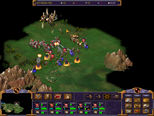 Ever since Warcraft
II, game companies have periodically swamped the public with gluts of real-time strategy
games. There was the great RTS boom of ’97, another in ’99, and right now it
looks like we’re in the middle of another one. Whenever one of these booms hits, you
can be sure that the publicity machines will begin to crank out copy claiming that this
new wave of RTS’s doesn’t have much in common with “your daddy’s
RTS”. Sometimes they don’t—like Homeworld or Ground Control or the Close
Combat series—but these games tend to be so different that they don’t
really bear much resemblance to the “classic” real-time strategy game anyway.
More commonly, new RTS’s are very much like your father’s, if in fact your
father was playing RTS’s in 1997. While
I enjoy a good game of AoE or Red Alert 2 as much as anyone, it bespeaks a certain lack of
originality when game companies churn out title after title whose only differences are
minor tweaks to the game engine or a matter of setting--whether you’re fighting Space
Goons, Nazis, or Elves, most RTS’s play pretty much the same. Which is why I like
Kohan: Immortal Sovereigns so much. While it looks a lot like your standard cut-and-paste
RTS, it’s full of elegant little quirks and variations that make it a true original.
And it plays like a bastard, too. Ever since Warcraft
II, game companies have periodically swamped the public with gluts of real-time strategy
games. There was the great RTS boom of ’97, another in ’99, and right now it
looks like we’re in the middle of another one. Whenever one of these booms hits, you
can be sure that the publicity machines will begin to crank out copy claiming that this
new wave of RTS’s doesn’t have much in common with “your daddy’s
RTS”. Sometimes they don’t—like Homeworld or Ground Control or the Close
Combat series—but these games tend to be so different that they don’t
really bear much resemblance to the “classic” real-time strategy game anyway.
More commonly, new RTS’s are very much like your father’s, if in fact your
father was playing RTS’s in 1997. While
I enjoy a good game of AoE or Red Alert 2 as much as anyone, it bespeaks a certain lack of
originality when game companies churn out title after title whose only differences are
minor tweaks to the game engine or a matter of setting--whether you’re fighting Space
Goons, Nazis, or Elves, most RTS’s play pretty much the same. Which is why I like
Kohan: Immortal Sovereigns so much. While it looks a lot like your standard cut-and-paste
RTS, it’s full of elegant little quirks and variations that make it a true original.
And it plays like a bastard, too. 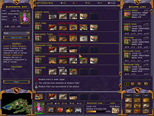 That being said,
Kohan’s setting won’t exactly overwhelm you with its novelty. Kohan takes place
in the pretty standard fantasy world of Khaldun, where some really evil force has taken to
setting off occasional cataclysms that destroy the world. Fortunately for you, you play
the role of one of the Kohan, a race of 100,000 immortals who reawaken from these
cataclysms like sailors from a bender, devoid of memory but dimly aware that some terrible
event involving them has transpired in the recent past. The land they find themselves
in—Khaldun--is full of monsters, and its society divided into four factions—the
Nationalist, Council, Royalist, and Ceyah. The three factions consist mostly of
garden-variety human troops; the Ceyah are undead. Your job is to recover you memory,
confront the ultimate bad guy, and cut down on the frequency of those cataclysms. That being said,
Kohan’s setting won’t exactly overwhelm you with its novelty. Kohan takes place
in the pretty standard fantasy world of Khaldun, where some really evil force has taken to
setting off occasional cataclysms that destroy the world. Fortunately for you, you play
the role of one of the Kohan, a race of 100,000 immortals who reawaken from these
cataclysms like sailors from a bender, devoid of memory but dimly aware that some terrible
event involving them has transpired in the recent past. The land they find themselves
in—Khaldun--is full of monsters, and its society divided into four factions—the
Nationalist, Council, Royalist, and Ceyah. The three factions consist mostly of
garden-variety human troops; the Ceyah are undead. Your job is to recover you memory,
confront the ultimate bad guy, and cut down on the frequency of those cataclysms.
You’ll begin
to notice the game’s originality when you first examine its resource management
system. While you’ll need to manage resources carefully to win the game, Kohan’s
system requires none of the tedious micromanagement of peon units that most RTS’s
require. This is partly due to the fact that the game’s resources--stone, wood, iron,
and mana--are produced mostly by buildings in your cities, though you’ll stumble
across the occasional mine that can be exploited. These resources are used to maintain
buildings and supply your units, and can also be converted to gold through exportation or
building markets. Gold can also be obtained through banking and taxation, and is used to
build structures and recruit troops. While the resource system is very manageable, it
takes a bit of experience and subtlety to master. Resources accrue by the minute and
what’s not used is lost, so it’s important to convert excess resources to gold,
which can be stockpiled. On the other hand, as your empire expands you’ll find that
you need more resources to maintain structures and supply units in the field. If you lack
the necessary resources for upkeep, you’ll be forced to purchase them with your gold.
When that runs out your units will begin to disintegrate where they stand. Resource
management is almost a game in itself; it’s a very delicate and rewarding balancing
act that is often decisive.
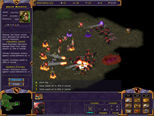 But the most
innovative thing about Kohan’s gameplay is its emphasis on the company as the basic
combat unit. In most RTS’s, you simply produce tons of individual units, group them
either somewhat deliberately by pressing CTRL+NUM or utterly haphazardly by clicking and
dragging, and send them off into battle. In Kohan, companies consist of three elements.
The first of these is your “front line” element, which stands at the head of
your formation dealing out hand-to-hand punishment or firing ranged weapons. These usually
consist of four of your individual infantry, cavalry, or missile units. The second element
of your company is the “support” element--these can either be made up of reserve
units of your front line troops or ranged units that can engage the enemy from behind the
protection of your grunts or (best of all) special support units like paladins, rangers,
and magicians who can cast very nasty spells and provide special abilities to the company.
The third element is made up of a hero, who can be either a powerful leader or one of the
even more powerful Kohan you’ll find scattered throughout the scenarios. . Depending
on the type of leader you use, you’ll have to decide whether to allow him or her to
engage the enemy or to stand back and command the company. You can kit your companies out
as you see fit, and the tripartite company composition gives your units plenty of
flexibility. You can recruit heavy infantry with bow support, or muster light infantry
supported by vicious magic attacks. One of my
favorite ploys is to create a heavy cavalry unit and add a ranger unit as support. Since
ranger units allow companies to travel through rough terrain without penalty and also
increase the company’s visual range, I like park this unit in heavy woods, from
whence they can quickly charge out to ambush opposing units unawares. But the most
innovative thing about Kohan’s gameplay is its emphasis on the company as the basic
combat unit. In most RTS’s, you simply produce tons of individual units, group them
either somewhat deliberately by pressing CTRL+NUM or utterly haphazardly by clicking and
dragging, and send them off into battle. In Kohan, companies consist of three elements.
The first of these is your “front line” element, which stands at the head of
your formation dealing out hand-to-hand punishment or firing ranged weapons. These usually
consist of four of your individual infantry, cavalry, or missile units. The second element
of your company is the “support” element--these can either be made up of reserve
units of your front line troops or ranged units that can engage the enemy from behind the
protection of your grunts or (best of all) special support units like paladins, rangers,
and magicians who can cast very nasty spells and provide special abilities to the company.
The third element is made up of a hero, who can be either a powerful leader or one of the
even more powerful Kohan you’ll find scattered throughout the scenarios. . Depending
on the type of leader you use, you’ll have to decide whether to allow him or her to
engage the enemy or to stand back and command the company. You can kit your companies out
as you see fit, and the tripartite company composition gives your units plenty of
flexibility. You can recruit heavy infantry with bow support, or muster light infantry
supported by vicious magic attacks. One of my
favorite ploys is to create a heavy cavalry unit and add a ranger unit as support. Since
ranger units allow companies to travel through rough terrain without penalty and also
increase the company’s visual range, I like park this unit in heavy woods, from
whence they can quickly charge out to ambush opposing units unawares.
You can also deploy
your companies in different formations, including pressed and regular column, skirmish,
and battle. Column formation allows for fast
movement but awful combat readiness, battle for slow movement but excellent combat
effectiveness, skirmish for a combination of the two. Terrain must be taken into account
as well; it adds to a unit’s defense value, and if a company remains in one place for
long enough it will automatically fortify its position.
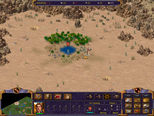 Tactics also play a
large role in the game; tank rushing into the fray is often disastrous. It’s
important to think about stuff like flanks and deployment, which play virtually no role in
most RTS’s. For example, since your front line units usually are arrayed to
the--well, front--of your company’s formation, it takes a while for enemy units to
fight their way through them to kill your often-powerful yet fragile support units.
Unless, that is, they take you in the flank, in which case said support units are toast.
Kohan’s gameplay thus places a premium
on coming up with flexible and effective unit compositions, deploying them in the right
formations, and carefully choosing the ground for one’s battles. This means that
combat in Kohan is more deliberate and thoughtful than other RTS games. By far. Tactics also play a
large role in the game; tank rushing into the fray is often disastrous. It’s
important to think about stuff like flanks and deployment, which play virtually no role in
most RTS’s. For example, since your front line units usually are arrayed to
the--well, front--of your company’s formation, it takes a while for enemy units to
fight their way through them to kill your often-powerful yet fragile support units.
Unless, that is, they take you in the flank, in which case said support units are toast.
Kohan’s gameplay thus places a premium
on coming up with flexible and effective unit compositions, deploying them in the right
formations, and carefully choosing the ground for one’s battles. This means that
combat in Kohan is more deliberate and thoughtful than other RTS games. By far.
It doesn’t
hurt any that the computer AI is pretty smart. It will do things like run from fights it
doesn’t think it can win, and then come back later with reinforcements. Kohan also
includes a diplomatic model, and the computer AI is actually on the sly side. If it thinks
it can gain an advantage, it will blithely break an alliance and turn on you. Watch out.
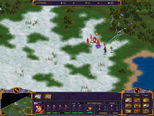 The game’s
single-player campaign is made up of sixteen missions and isn’t exactly inspired, but
it does serve as an excellent tutorial for skirmish and online play. In fact, the early
missions of the single player game are tutorials, and they do a fine job of introducing
the player to the game’s basic and more advanced mechanics. Before you go online
you’ll want to spend some time reading the manual, which is very well done but could
use an index. The game’s
single-player campaign is made up of sixteen missions and isn’t exactly inspired, but
it does serve as an excellent tutorial for skirmish and online play. In fact, the early
missions of the single player game are tutorials, and they do a fine job of introducing
the player to the game’s basic and more advanced mechanics. Before you go online
you’ll want to spend some time reading the manual, which is very well done but could
use an index.
But if the
single-player campaign is a bit lackluster, Kohan’s
skirmish and online games are stellar. There are plenty of options and maps for skirmish
games, and finding a game online is a snap with Kohan’s built-in Gamespy support.
Since Kohan contains so much depth and flexibility, online games never seem to play out
quite the same way. One thing for sure, though; be certain to have a good grasp of how to
manage resources before hooking up with the online community. Astute resource management
will go a long, long, way towards making you competitive.
The game’s
graphics are excellent, and really shine during the game’s animated combats. Spell
effects are particularly awe-inspiring, and the game’s interface conveys all the
information you need without being intrusive. Sound is very good and voice acting better
than average.
 Overall, Kohan is a
mighty impressive package and the best RTS we’ve played in ages. It’s
good-looking, deep, smart and a lot of fun, and places more of an emphasis on strategy and
tactics than any RTS I can call to mind. In fact, we’re willing to tag Kohan:
Immortal Sovereigns as one of
the best RTS games ever--worthy of standing alongside classics like Starcraft and Age of
Empires. Overall, Kohan is a
mighty impressive package and the best RTS we’ve played in ages. It’s
good-looking, deep, smart and a lot of fun, and places more of an emphasis on strategy and
tactics than any RTS I can call to mind. In fact, we’re willing to tag Kohan:
Immortal Sovereigns as one of
the best RTS games ever--worthy of standing alongside classics like Starcraft and Age of
Empires.
Rick
Fehrenbacher |
